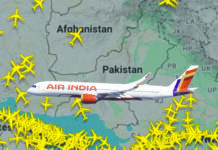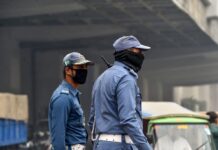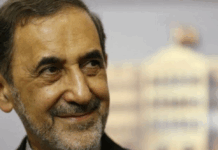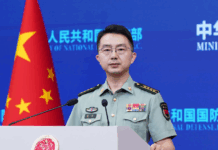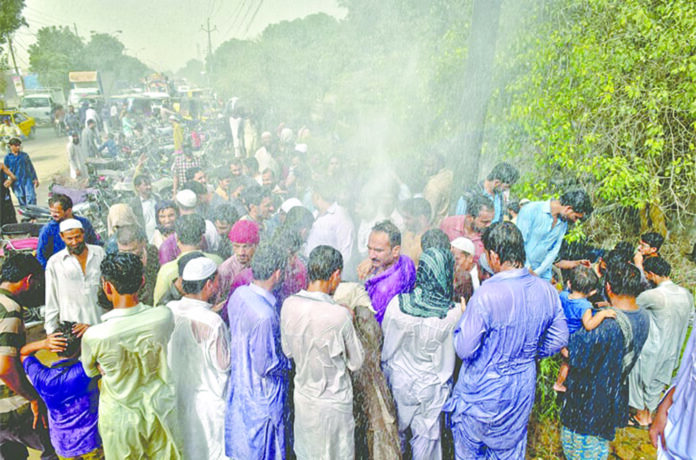Heat waves are increasingly becoming a significant public health issue globally, particularly in urban areas. Karachi, Pakistan’s largest city, is no exception. Recently, Karachi has experienced extreme temperatures, with the “feels like” temperature soaring to 51°C. A heat wave is a period of excessively hot weather, which may be accompanied by high humidity, especially in oceanic climate countries. The primary driver of heat waves is climate change, induced by the accumulation of greenhouse gases such as carbon dioxide (CO₂) and methane (CH₄) in the atmosphere. These gases trap heat, creating a “greenhouse effect” that raises global temperatures.
Additionally, heat waves are influenced by atmospheric pressure systems. High-pressure systems can create a dome of hot air, preventing cooler air from entering the region. This phenomenon, often referred to as a “heat dome,” can lead to prolonged periods of high temperatures.
The urban heat island (UHI) effect is another critical factor, particularly relevant to cities like Karachi. The UHI effect occurs when urban areas become significantly warmer than their rural surroundings due to human activities. Concrete, asphalt, and buildings absorb and retain heat, raising local temperatures. Limited vegetation and green spaces exacerbate this effect.
Prolonged exposure to high temperatures can cause a range of health issues, from heat exhaustion and heatstroke to severe dehydration. Vulnerable populations, including the elderly, children, and individuals with pre-existing health conditions, are particularly at risk. Heat waves also exacerbate respiratory and cardiovascular conditions. High temperatures can increase the concentration of pollutants like ozone at ground level, which can trigger asthma and other respiratory diseases. Cardiovascular stress is also a concern, as the body works harder to maintain a stable internal temperature.
Heat waves can lead to severe environmental consequences. They exacerbate drought conditions, leading to water scarcity. Increased temperatures also elevate evaporation rates, which can deplete water bodies and soil moisture, impacting agriculture and ecosystems.
Economically, heat waves lead to increased energy demand as people rely more on air conditioning and cooling systems. This surge in energy use can strain electricity grids, leading to power outages and higher energy costs for consumers. For example, during the 2006 California heat wave, energy demand soared, resulting in widespread power outages and economic losses estimated at over $1 billion.
Heat waves also affect labour productivity, particularly in outdoor and non-air-conditioned environments. High temperatures can reduce workers’ efficiency and increase the risk of heat-related illnesses, impacting industries such as construction, agriculture, and manufacturing. Additionally, the healthcare system faces increased pressure due to a rise in heat-related illnesses, leading to higher healthcare costs.
Karachi’s geographical and socio-economic factors exacerbate the challenges posed by heat waves. The city’s coastal location typically benefits from the moderating effects of the sea breeze. However, during heat waves, high-pressure systems can block this breeze, causing temperatures to spike. Hot winds from Baluchistan further exacerbate the heat, creating extremely uncomfortable conditions.
The urban heat island effect is pronounced in Karachi due to its dense population and extensive concrete infrastructure. The city’s rapid urbanization has led to a significant reduction in green spaces, with concrete and asphalt surfaces absorbing and retaining more heat. This not only raises local temperatures but also contributes to poor air quality and increased energy consumption.
As global temperatures continue to rise, proactive and collaborative efforts are essential to protect vulnerable populations and ensure the sustainability of urban environments. By learning from global examples and implementing innovative urban planning and infrastructure improvements, Karachi can develop effective strategies to combat the heat wave crisis and create a more livable and resilient city.
Socio-economic disparities mean that many residents lack access to adequate cooling systems and healthcare, making them more vulnerable to the impacts of extreme heat. Informal settlements, which house a significant portion of Karachi’s population, are particularly susceptible as they often lack basic infrastructure and services.
Addressing the challenges posed by heat waves in Karachi requires a comprehensive approach to urban planning and infrastructure improvements. This includes both immediate and long-term strategies aimed at reducing temperatures, improving living conditions, and building resilience against future heat waves.
One of the most effective strategies for mitigating the urban heat island effect is the implementation of green infrastructure. This includes increasing the number of parks, green roofs, and tree-lined streets. Vegetation cools the air through a process called evapotranspiration, where plants absorb water through their roots and release it as vapour through their leaves. This process not only lowers temperatures but also improves air quality.For example, Singapore’s “City in a Garden” initiative has transformed the city into a green oasis, with extensive tree planting and green spaces. This has significantly reduced urban temperatures and improved residents’ quality of life. Karachi can benefit from similar initiatives by incorporating more green spaces and promoting urban forestry.
Promoting the use of reflective and cool roofing materials can also help reduce indoor temperatures. These materials reflect more sunlight and absorb less heat, making buildings cooler and reducing the need for air conditioning. Building codes and regulations should encourage designs that minimize heat absorption and improve insulation. In Los Angeles, the Cool Roof programme mandates the use of reflective roofing materials for new and refurbished buildings. This has led to significant reductions in energy consumption and indoor temperatures. Implementing similar policies in Karachi can help mitigate the effects of heat waves.
Transitioning to renewable energy sources is essential in reducing greenhouse gas emissions and combating climate change. Renewable technologies, such as solar panels and wind turbines, provide sustainable energy solutions that reduce the reliance on fossil fuels. This not only helps mitigate climate change but also reduces the urban heat island effect. Germany’s Energiewende initiative aims to transition the country to a renewable energy-based economy. This has significantly reduced greenhouse gas emissions and increased the use of renewable energy sources. Karachi can benefit from investing in renewable energy infrastructure to reduce its carbon footprint and combat the effects of heat waves.
Educating the public about the risks of heat waves and how to stay safe is crucial. Public awareness campaigns should emphasize the importance of staying hydrated, avoiding outdoor activities during peak heat, and recognizing the symptoms of heat-related illnesses. Community engagement is also essential in developing and implementing effective heat wave mitigation strategies.
Establishing cooling centres in public buildings, such as schools, community centres, and libraries, can provide relief for those without access to air conditioning. These centres should be well-publicized and accessible to all residents. Additionally, emergency services should be equipped to respond to heat-related incidents, including providing first aid and transporting individuals to cooling centres. During the 2019 heat wave in Europe, cities like Paris and Berlin opened cooling centres and extended the hours of public swimming pools to provide relief for residents. These measures helped reduce heat-related illnesses and deaths. Karachi can benefit from similar strategies to protect vulnerable populations during heat waves.
Innovative building designs and urban planning can significantly reduce the impact of heat waves. This includes designing buildings that maximize natural ventilation and shade, using materials that reflect heat, and incorporating green roofs and walls. Urban planning should prioritize the development of green spaces, water bodies, and shaded areas to create a cooler urban environment. The city of Medellín, Colombia, has implemented a “Green Corridors” project, which involves transforming roads and riverbanks into green spaces. This has significantly reduced temperatures and improved air quality in the city. Karachi can adopt similar urban planning strategies to mitigate the effects of heat waves.
Comprehensive climate adaptation plans tailored to Karachi’s specific vulnerabilities are essential. These plans should be based on robust data and involve input from a wide range of stakeholders, including government agencies, scientists, and community groups. Effective governance and policy-making are crucial for implementing and sustaining heat wave mitigation strategies. The Netherlands has developed a National Climate Adaptation Strategy that outlines measures to protect against extreme weather events, including heat waves. The strategy includes investments in green infrastructure, water management, and public awareness campaigns.
Heat waves pose a significant threat to cities like Karachi, with severe impacts on health, the environment, and the economy. Addressing this challenge requires a comprehensive approach that includes both immediate and long-term measures. By increasing public awareness, improving urban infrastructure, and implementing sustainable practices, Karachi can mitigate the effects of heat waves and build resilience against future climate challenges.
As global temperatures continue to rise, proactive and collaborative efforts are essential to protect vulnerable populations and ensure the sustainability of urban environments. By learning from global examples and implementing innovative urban planning and infrastructure improvements, Karachi can develop effective strategies to combat the heat wave crisis and create a more livable and resilient city.



